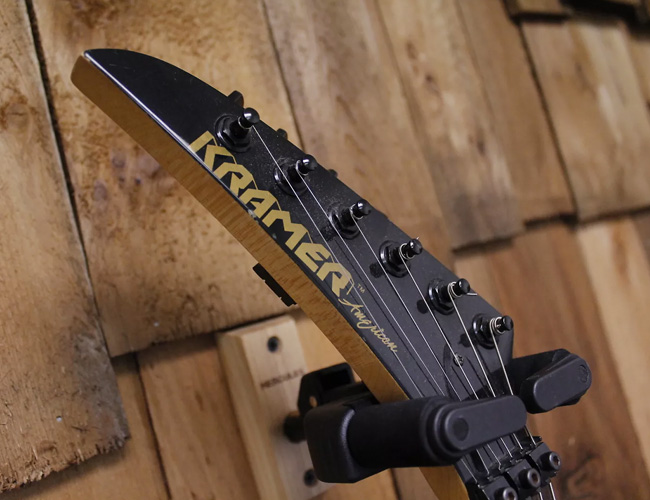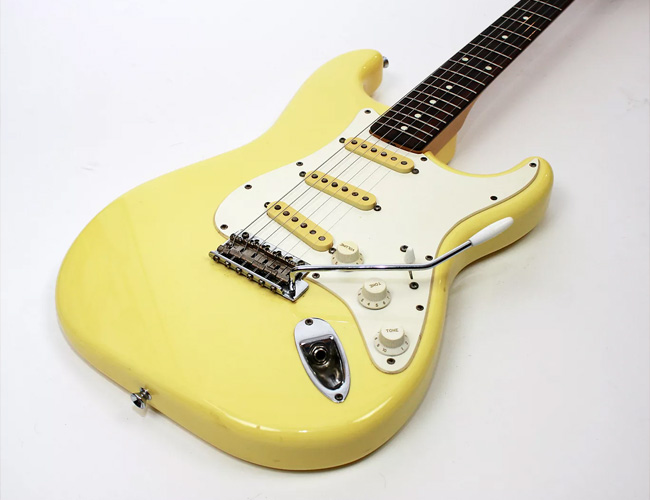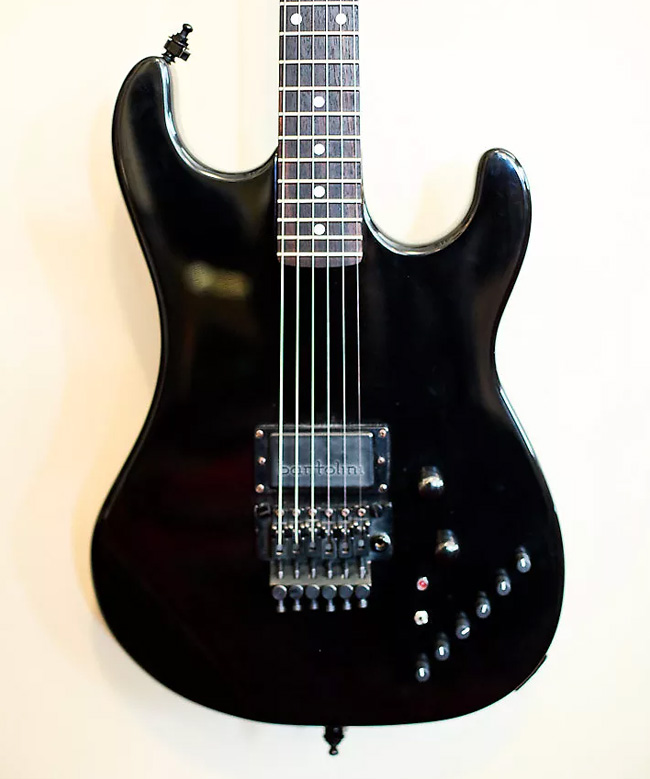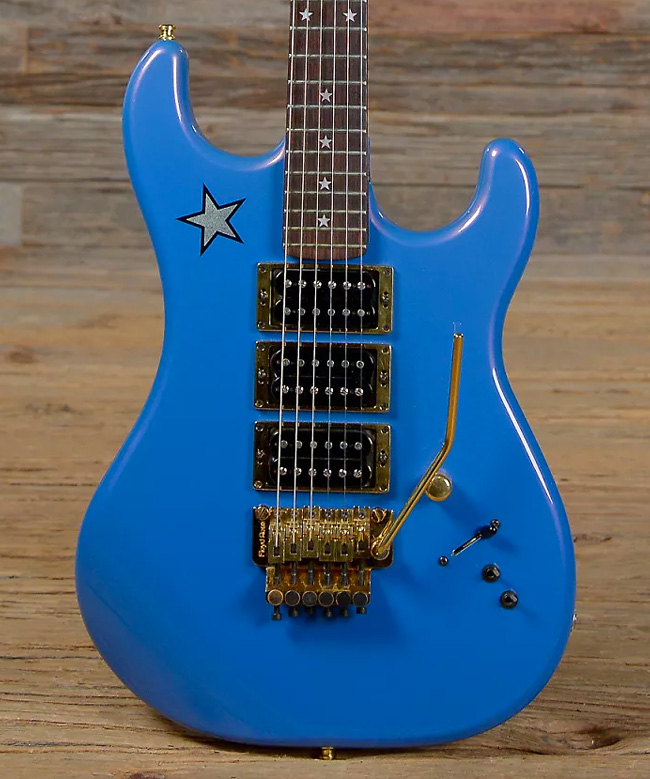Ahhh, the 1980s…
A lot can be and has already been said about this infamous decade, but rarely do we talk about its finest guitars. Little love is given to the cream of the ‘80s crop, which means that many of them are currently sitting on the used market at an excellent price point.
Today, we’re taking an opportunity to talk about golden-age Kramers, which were beautifully playing guitars that featured the finest innovations of the decade’s lutherie.

Sure, Kramers were all over hair metal videos and came in a variety of absolutely absurd finishes, but a great guitar is a great guitar and it’s likely only a matter of time before Kramer values skyrocket.
Kramer kicked off the ‘80s switching from their USA-made aluminum necks to mostly Japanese-made wood necks, quickly establishing itself as the premier global guitar brand in terms of quality and sales.
With the wholehearted endorsement of Eddie Van Halen — the foremost guitar hero of the 80s — Kramer rose to the top of the heap and enjoyed a reputation as the best guitar company around.
But much like the bands who played these guitars, succumbing to ‘80s excess would prove to be Kramer’s fatal flaw. Kramer’s later years imparted the brand with a lasting reputation for overbuilt guitars, but many players today are coming to realize how excellent those early Kramers were and still are.
The Golden Years
When players and collectors talk about Kramer at its peak as a guitar company, they’re talking about the production run from 1981 to 1986. The company’s output declined in quality from 1986 to its shuttering in 1989.
During that ‘81 to ‘86 run, Kramer was constantly updating designs. There was quite a bit of variation with the headstocks, neck shapes (C to Boat to Shredder), nut widths, tonewoods, pickups (Schaller to Seymour Duncan), electronics (stereo string panning, coil-splitting, hidden pickups), tremolos, and hardware. So, basically, Kramer played around with every element of what goes into an electric guitar.
The most consistent and widely recognized changes centered around the headstock shapes as described below. Those headstock changes are key when deciphering how to date your Kramer.
The Pacer
From the beginning, Kramer clearly embraced Super Strat culture. The Pacer was Kramer’s signature take on that form, and its early flagship model that showcased Kramer’s forward-thinking design philosophy.
One of the most visible and significant emblems of their approach was the wealth of non-traditional pickup combinations available for this series. The Pacer was one of the first Strat-style guitars sold stock in multiple versions with a humbucker in the bridge position.

The other feature that made the Pacer stand out was its locking tremolo—a feature that Kramer embraced before any other mainstream guitar company. Originally, Kramer employed the Rockinger tremolo but switched over to the Floyd Rose before long. Early Pacers featured a vintage-style flicker tremolo, but these soon faded out making them rarer finds today.
Then, as with much of Kramer’s output, there is a litany of quirky variations across the years in the Pacer line.
For one, when the Pacer debuted, it came out under the Walker brand (Kramer’s original wooden-neck brand) sporting a Walker decal on its Fender Strat-style headstock. In 1982, Kramer switched to its classic beak headstock with a Kramer logo. Between those two headstock eras was a Strat headstock with a Kramer logo.
Walker Pacers tended to have headstocks painted to match the body, while most of the early beak Kramer Pacers were maple-faced. When the Pacer changed to the hockey stick headstock, painted headstocks became the standard.
The ESP factory—where those necks were produced—was known for outstanding craftsmanship.
Coming hot on the heels of the so-called Lawsuit Era in Japan—when factories were turning out high-quality copies of American guitar designs—the early 1981 to 1983 Pacer necks owe a lot to the ones on classic Stratocasters, featuring a shape similar to an old school Fender C.

In 1984, Kramer would transition to a thinner, boat profile until those necks got to maximum shred levels post-’86. From a player’s standpoint, the earlier beak necks are generally favored, but it has proven to be a matter of preference. The banana-era necks are quite popular as well.
The first models generally donned one-piece maple necks with skunk stripes. There were some that featured rosewood fingerboards and even some one-offs that included both the skunk stripe and a rosewood board.
Neck construction became more complex sometime in 1984 when Kramer transitioned to the banana-shaped headstock. After that point, it became uncommon to see a Kramer guitar (more specifically, a Pacer or Baretta) with a maple fingerboard or even a one-piece maple neck, unless it was a custom guitar.
The new necks were typically constructed of three pieces, which sometimes led to complications. A small number of 1984 and 1985 Pacers suffered from joint separation at the headstock due to a bad batch of glue. Rumor has it that most of these instruments were recalled, but from my personal experience, you can still find a few out in the wild — some with that bad gluing repaired.
Eddie Van Halen and the Baretta
It’s impossible to talk about Kramer and not mention Eddie Van Halen. Riding high (and perhaps drunk) off of his enormous success in Van Halen, Eddie was approached by Kramer to develop and release his own signature guitar.

While Eddie initially pushed for the guitar to be a spot-on replica of his beat-up Frankenstrat, Kramer executives deemed it cost-prohibitive. There’s also the story out there that the higher-ups thought the idea of selling a guitar that was purposefully made to look beat-up or aged was beneath their brand.
The most significant result of Kramer and Eddie Van Halen’s collaboration was the Baretta, introduced in 1983.
Like the early Pacer Customs, these had Strat-style bodies with a single bridge humbucker. Yet the features that made the Baretta different from the old Pacer Custom were subtle and numerous. On the Baretta, the bridge humbucker was slanted to better align the poles of the pickup with the strings. This was done to address the addition of the original Floyd Rose tremolo.
Initially, EVH got Kramer to use the Rockinger Tremolo, which Kramer briefly dubbed the Eddie Van Halen tremolo. But Eddie and customers alike had some issues with the Rockinger, thanks to its brass-on-brass construction, which made for unstable tuning and early wear.
Shortly after introducing the Floyd Rose in 1983, Kramer switched to using this tremolo exclusively.
The Baretta also introduced the banana headstock. The Baretta’s neck was thinner than the Pacer’s, spurring quick evolution in Kramer necks.

These guitars also featured early Seymour Duncan pickups, as opposed to the Schaller pickups that came stock in earlier Kramers. Seymour Duncan would eventually become the standard pickups in all American Series Kramer’s sometime around 1986.
Up until the introduction of the Baretta I and II in 1986, Barettas were consistently excellent guitars that remain beloved to this day. Kramer’s shift to a Jackson-style, pointy headstock in 1986 alienated much of its die-hard fan base.
While some respected models did come out of this year/era (such as their first neck-through model, the Stagemaster), this misstep and the influx of cheaper international models resulted in a perceived — and soon, literal — decline in the prestige and quality of the brand.
Kramer fell victim to a number of bad business decisions (which may or may not have involved a Russian hair metal band) before filing for bankruptcy at the close of the ‘80s. It was a sad and unfortunate demise in the classic sense for a company that at one point showed unparalleled promise.
The Gems, Lemons, and Exceptions
Like Fender, Kramer had an outstanding budget MIJ series. That Focus series covered all of the major Kramer models at the time, including the Pacer and Baretta, and were startlingly good for their price point.
The necks and bodies were made at the same ESP factory where the lion's share of the parts for the American Series were produced. The main difference is that the American Series guitars were shipped back to the States for assembly.
Japanese production/assembly wasn’t exactly behind the US at the time, and when you factor in that these guitars also had early Seymour Duncan pickups and original Floyd Rose tremolos, there is a lot of bang for your buck with Focuses.

Another underrated set of models to come out were the Classic series. This series hosted Kramer’s USA-assembled, traditional take on the Strat and Tele. These guitars tend to age gorgeously and combined classic Fender stylings with Kramer’s construction innovations.
For example, the Classic’s Strat was packed with three vintage-style Seymour Duncan single-coil pickups and had a fourth pickup hidden under the pickguard for hum-canceling. It also featured a vintage Strat-style flicker tremolo that originally appeared on the Pacer, along with a more Fender-style neck shape.
The USA Classics can be a bit on the pricey side, but there was also a Focus series made of the Classic and they are pretty affordable.
While many of the Kramers from this time are quality instruments, others are not so much. For one, the Korea-based Striker series is often derided and avoided by Kramer lovers. Intended for beginners, Strikers and other overseas models were made out of plywood as opposed to ash, poplar, alder, and maple like their Japanese and USA counterparts.
It can sometimes be hard to tell if a Kramer is made overseas because Kramer (like other companies at that time) intentionally made it unclear for their own marketing purposes. You can read more about this in our “How to Date Your Kramer” article.
The exciting part about Kramer is that they made a lot of interesting guitars that time has almost completely forgotten. The Ripley Stereo guitar an out-of-this-world technical creation, but people rarely talk about it. It was designed for Eddie Van Halen and had six knobs, each panning an individual string.

1986 Kramer Ripley RSG-1

1986 Kramer Triax
At NAMM 1986, Kramer signaled a move toward metal guitars with the flashy, intergalactic Triax and Enterprize guitars. While these models were never intended for mainstream production (there are a few NAMM editions on our marketplace), they proved that Kramer had its own spin on ‘80s excess.
Kramer also had a number of signature artist guitars that are not often talked about. The most prominent in the late ‘80s was Richie Sambora’s signature model. This guitar featured three humbuckers with gold-surrounds on a Strat-style body with a Floyd Rose tremolo. It briefly became a popular model before being phased out in 1989 when Sambora switched allegiance to Fender.

1987 Kramer Richie Sambora Signature

1988 Kramer Elliot Easton E.E. Pro 1
The Elliot Easton signature (prototyped by legendary builder Tom Anderson) is arguably the Kramer Signature that has aged the best in terms of features and aesthetic. It’s like a ‘87 JEM mixed with a vintage Fender, featuring a Brazilian rosewood fingerboard. The visual design of the Elliot Easton is as steeped in the '80s color palette and Futurism as it is in classic '50s guitar shapes.
The prices on these can fluctuate a decent amount, so it’s possible to get an Elliot Easton for a steal if you keep your eyes peeled.
Kramer Guitars and Basses